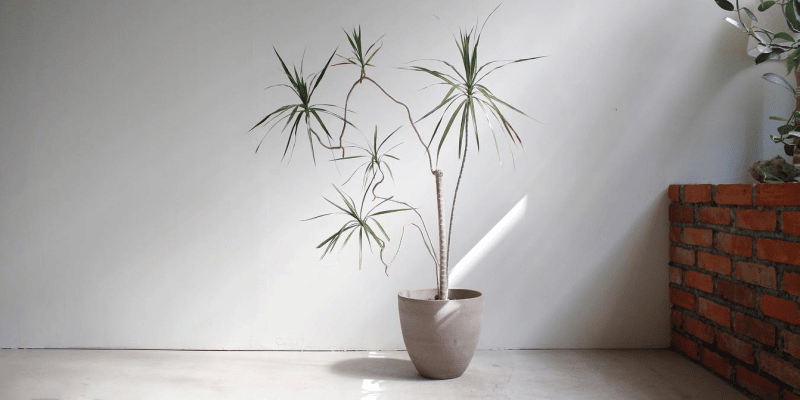Are you tired of finicky plants that seem to wilt and have issues no matter how much care you give them? Enter Dracaena marginata: the Dragon Tree.
With leaves that are brightly colored and bordered in red, they look more like a collection of swords sometimes than a plant. These exotic plants from Madagascar can thrive in a variety of conditions.
Dragon trees aren’t without their issues, including a very specific water preference, but these aren’t hard to remedy, and we’ll cover the essentials of care, propagation, and growth in this article.
So join us on this journey as we explore the fiery and mesmerizing beauty of the Dragon Tree!
(Was that… too much?)
Table of Contents
Dracaena Marginata ‘Dragon Tree’ Care Guide
History, habitat, and characteristics
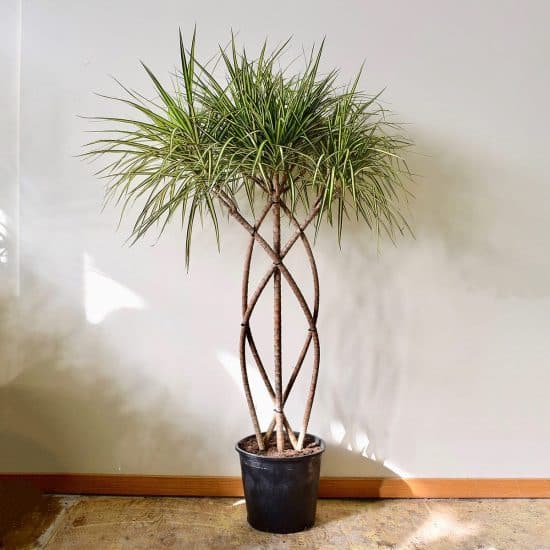
Dracaena Marginata — or Dragon Tree, as it’s commonly known — is an absolutely captivating species of Dracaena that shows off some of its fiery nature with its bright, red-edged leaves that emerge like swords from its stems.
(Its name comes from these illuminating edges and the red resin it produces if cut.)
Though native to the coastal forests of Madagascar, the Dragon tree is a versatile beauty that has worked its way into homes and gardens alike throughout the world, and it’s no surprise: it’s tolerant of a variety of care conditions.
Dragon trees are sensitive to minerals and really prefer filtered water. They do best in bright, indirect light and should be watered when the soil is dry to the touch, as a drought-tolerant plant.
Regularly cleaning the dust off its glossy leaves can help maintain its neat margins and keep this slow-growing plant from being even slower!
Though in its natural habitat, it can reach heights of up to 40 feet, in cooler climates (aka indoors), it tends to fare better when protected from freezing temperatures and strong winds. Though it rarely blooms indoors, when kept in ideal conditions and with special care, it can produce white flowers in the spring. Dragon Trees usually grow between 2-6 feet indoors and should be kept away from pets.
Elaborate, eye-catching, and just a bit mesmerizing, the Dracaena marginata is going to be a fun plant to explore in this article, so let’s get into its care.
Picking out a Dracaena marginata
Before we get into the varieties available, let’s cover how to approach selecting the right Dragon Tree to take home with you. If you’re purchasing your plant online, make sure to check the reviews of the shop and any shipping/return policies.
If you’re shopping at a local garden center or nursery, you’ll want to start by inspecting the central stem: you’ll see at the top where it was the grower originally cut it for shipping.
You should see 3-4 separate stems emerging, each branching off. This is a great sign that your Dragon tree was exposed to the high humidity it loves and taken care of during growing. If you only see a single stem, consider picking a different plant.
Okay, on to Dragon Tree varieties!
Varieties
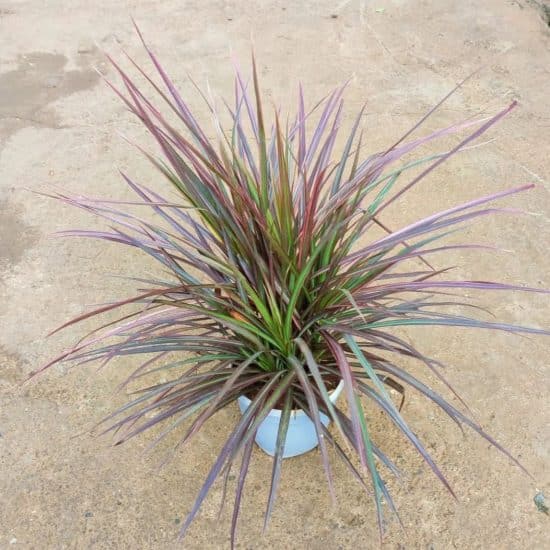
We aren’t limited to just Dracaena marginata: there are a variety of cultivars available, each with its own unique qualities.
Throughout Dracaena, we really have a full selection available. We can decide on stem color (green, brown) or whether it even has a stem at all.
Leaf appearance is probably where most eyes linger, and there we have thickness, colors, striping, and ease of care. Some varieties have smaller leaves; these tend to be slow growers indoors.
A word on care: the largest difference in care is that variegated Dracaena will need more light than non, as they are less green.
Dracaena marginata colorama – looking almost like a striped candy, it features stripes of dark green, light green, and vivid reds and pinks.
Dracaena marginata bicolor – more subdued than the colorama, we primarily see thin bands of green bordered with white and then pink.
Dracaena marginata tricolor – thin strips of yellow, green, white, and pink variegation; grows more slowly than other varieties and loves light.
Dracaena marginata tarzan – looks very similar to the original Dragon Tree. This cultivar features thicker leaves and trunk, and less pink on the edges.
Light
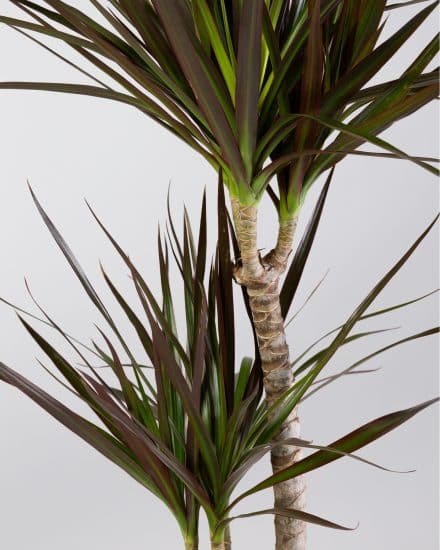
Madagascar dragon tree loves sunlight, and lots of it. As we mentioned just above, the less green your leaves are, the more they’ll appreciate indirect sunlight.
How far away we place a Dragon tree from the window will depend on the direction it faces. Typically, a south-facing window is fine as long as you’re at least 3-4 feet away.
Check the path of the sun and just make sure you aren’t leaving your plant in direct sunlight for too long: we’d prefer to avoid it completely. Partial shade is well-tolerated.
The first sign you’ll see of sun damage will often be in your plant’s pink edges, which will turn brown and crumble. Pests will then come in to take advantage of the damaged plant, and care gets a lot harder.
If you notice your leaves getting yellowish green and your colors fading/muting, this is another sign of too much light.
Too little light is very easy to spot on the variegated Dracaena — they turn almost completely green and will grow much more slowly.
- Give Dracaena marginata bright, indirect sunlight.
- If the leaves begin to yellow, your plant is likely getting too little light — move it to a brighter spot.
- If the leaves start to darken or curl, the plant is likely receiving too much light. Relocate it to a spot with less direct sun.
Water
The main issue that Dragon tree plants have with water is actually the quality: they are very mineral sensitive. If you can, use filtered water, distilled water, even rainwater is great.
Early signs of mineral damage look like brown leaf tips that turn yellow, and then finally back to green as they reach the center of the leaf. This is a sign that your Dragon tree is attempting to move those minerals through the plant. Just snip off these sections and improve the quality of water as soon as you can.
Watering frequency comes down to soil, primarily, so you’ll want to test with a finger to see if it’s still moist. Typically you can water once a week in the growing season (once you feel the soil is dry) and a little less frequently in the winter, every 10-14 days.
Water tips:
- Water deeply with distilled or filtered water, letting it drain out of the bottom of your pot. Non-fluoridated water from the tap is usually just fine.
- If your leaves are yellowing, this is often a sign that something is off with your frequency, so feel that soil and make adjustments.
- Do not let your Dragon plant sit in standing water. It has to drain or you’ll damage this plant quickly.
Temperature and humidity
The Madagascar dragon tree is (as the name suggests) used to a warm climate that naturally has high humidity.
Most home temperatures will do just fine, but if you do leave it outside in the summer (which works great!) make sure to bring it in once it starts getting under 60 degrees in the evenings. Ideally you’ll keep it between 65 – 85 degrees F. This includes when you bring it home. If it’s much colder outside or in your car, try to keep it warm however you can, because cold temperatures do stress the plant.
Humidity is often a lot harder to control, but anywhere between 40-50% will keep it growing quickly. We often raise humidity during propagation and its growing season, and there are a few ways to can accomplish that.
To raise humidity:
- A tray filled with pebbles, stones, rocks, and water. The water evaporates off and our plants smile.
- Clustering plants together has been shown to raise humidity 3-7%. Just note that if your plant’s leaves touch, they’ll sometimes suffer mechanical damage (little brown spots). These are fine, just move them apart and cut any damaged sections off.
- If all else fails, a humidifier works great, even a small one.
- Boiling water or misting leaves? These are way too cumbersome, and you want to keep its leaves dry if at all possible, so set that spray bottle down.
Soil and planting
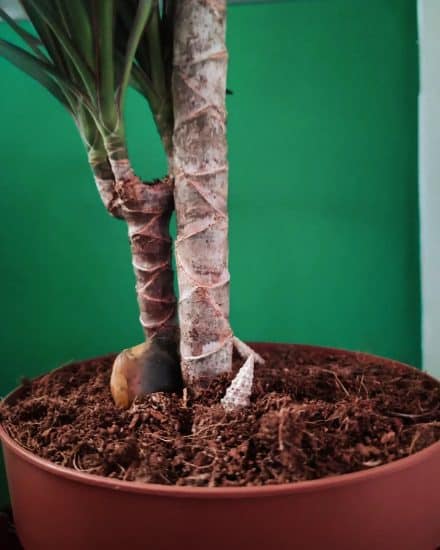
Madagascar dragon tree prefers soil that’s well-draining and not too peaty. So your average potting mix is a great start, but let’s add either:
- LECA
- pumice
- perlite
All three help the soil get better drainage so that it doesn’t stay moist for too long. Mix maybe 20-30% of one of those in. We’ve also heard of techniques using 100% pumice, which does seem in some studies to really encourage root growth and resiliency.
Remember, we want to give these plants nice big gulps of water, so we want that soil to hold water for just a little while before letting go. All three of these will do the trick.
Soil that stays moist for too long is a recipe for fungi, pests, and rot. Make sure your pot has drainage.
Repotting
Dracaena do not like to be repotted, but they also don’t like to be especially root bound. This does leave us with a bit of a problem. So how can we resolve it?
First, don’t repot immediately after bringing it home. It’s probably moved a few times recently before it arrived in your arms and is likely stressed. Wait at least a few months to let it settle into your home’s conditions, unless the soil has a serious issue that you’ve noticed.
When you do repot, do it in the early spring or fall. These are great times to repot a Dracaena because they’ve either been storing up energy all winter or are getting ready to expand their root systems (like in the fall).
Propagation guide
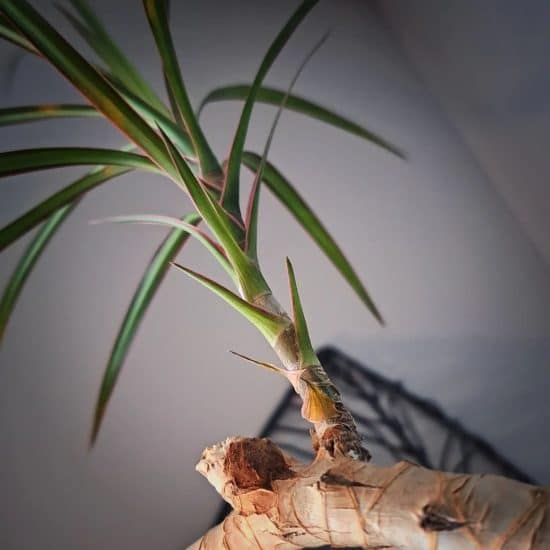
Propagating a Dragon tree is about as easy as it gets, and for many, it starts with pruning. We’ll be using a stem cutting in water approach, which is fast and lets us observe the amazing inner life of plants and the vast networks they produce just out of our vision!
Propagation
We’ll need a pair of shears, a jar, and some filtered or distilled water. Make sure to clean the shears with alcohol or in boiling water first.
- Whether you’ve just pruned off a chunk of your plant or you want to intentionally make another, we start by grabbing a stem that has at least 4-5 leaves higher up on it.
- Looking at the stem, you’ll see stripes or ridges, some of which have leaves growing out of them. These are nodes. We want to pluck out leaves from the bottom to reveal a good 3-4 inch segment of stem.
- When you have your prepared stem, make a clean new cut at the bottom and immediately place into water, changing it every couple of days.
- After a few weeks, you should see a substantial network of roots a few inches long taking hold. This is our cue to repot in the same soil mix we recommended in the section above.
We always want to have at least one of those nodes in the water, but based on how Dragon trees grow, we’ll likely have several.
As far as number of leaves on a propagation, anywhere from 3-6 is ideal. Too few, and there’s no way for the young plant to gather energy. Too many, and the energy requirements are too high for sustaining what’s already there without roots.
Alternatively, you can take top cuttings by slicing off a top portion of the plant below the leaf line, including at least one leaf node.
This cut-off top is planted the same way, and your Dragon tree should regrow multiple nodes from the top. Just make sure to provide your mature plant with plenty of humidity to ensure multiple branches appear.
Common issues
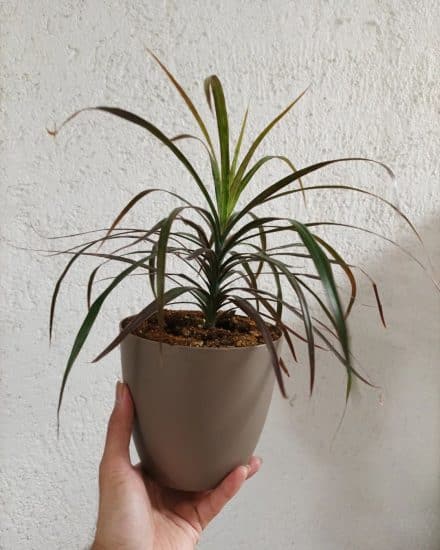
We did cover some unique issues that your Dragon tree might experience above. We’ll summarize those here, along with the most common issues that all indoor plants experience, namely yellowing leaves and brown leaf tips.
Yellowing leaves
Yellow Dragon tree leaves are almost always a water issue, which unfortunately can also be a soil issue… tough, I know, but they all have the same solution!
If you haven’t repotted your plant in a while and the soil takes a while to drain/dry out, this is a great opportunity to repot and improve that drainage.
Really make sure you let the soil dry out completely before watering — this means the top 1-3 inches.
If you have a variegated variety, this could also be a sign of too much indirect light, especially if the entire leaf is faded and they’re naturally a little bit yellow.
If the falling leaves are both yellow and lower leaves, that’s perfectly normal. The Dragon tree tends to lose these leaves as it climbs up.
Brown leaf tops or spots
Dry brown leaf tips can be caused by either mechanical damage (walking by the plant and brushing it, multiple plants being clustered together) or humidity that’s much too low.
If you notice brown tips that fade into yellow, this can be an issue with water impurities and a sign you need to filter you water.
Diseases and pests
Dragon tree is an attractive plant… but it can also be attractive to pests and fungi if we slack on the care. And honestly, be gentle with yourself, because all indoor plants attract pests — it’s pretty unavoidable.
Root Rot: Root rot usually occurs when the soil is overwatered or does not drain properly. A common sign of root rot can be yellowing, wilting and browning leaves, as well as spots on the leaves.
To fix the issue, check the soil and make sure it’s not too moist. Rot is always caused by too much water. Let the soil dry out fully before watering again. If the root rot has already set in, pull the plant out of its soil and check the roots for sliminess, blackness, or mushiness and trim off affected roots. Create a more draining soil mix for the plant and let it dry out completely between waterings.
Pests: Keep an eye out for pests such as mealybugs, spider mites and scale insects. Mealybugs typically are first noticed by the sticky, cottony deposit they leave on the leaves. Spider mites are more difficult to find, but you may see yellowing leaves and webs between the leaf nodes.
Isolate the plant, blast the bugs off with cold water, and then treat your plant with neem oil or soap. You can also use a bit of alcohol to remove any persistent pests.
Pests are attracted to dying leaves, which can occur lower down on the stem with mature plants. Make sure dead leaves don’t accumulate at the top of the soil, and prune off any damaged bits.
Conclusion
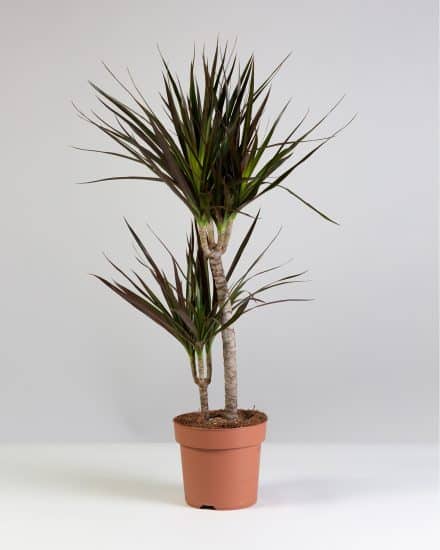
That’s it for our Dragon tree care guide. Like most plants, it does have a few unique quirks, but is otherwise an incredibly resilient plant that provides fantastic air filtration.
Quick summary:
- Water when the top inch or two of its potting mix feels dry to the touch.
- Wipe down any leaves if you do mist your plants to make sure dust doesn’t accumulate and that they stay dry.
- If your yellow, pink, and creamy striped leaves start becoming all green, increase the amount of indirect light.
- If your Dragon tree looks different than ours here, keep in mind that its stems and leaves both come in different colors.
- Dracaena marginata ‘Dragon Tree’ is easy to propagate via stem cuttings. Just make sure not to take a top cutting in dry air because it will have trouble regrowing. At least 40% humidity, please!
If you have any questions we haven’t answered, or want to send in a picture of your own Dracaena, drop us a line!
FAQ
What’s the difference between a Madagascar dragon tree and Dracaena Marginata?
They’re the same. Dragon tree goes by a lot of different names, mostly depending on the grower and region of the world you live in. All are of the Dracaena genus.
Do Dragon trees like direct sunlight?
Dragon trees do not tolerate either too much direct sun or persistent low light conditions. You want to give it a lot of bright illumination, ideally from a south or east-facing window.
How big does a Madagascar Dragon tree get?
Indoors, this depends on the variety, but it can get over 20 feet tall in the wild. Typically its height is limited by your ceiling indoors and the amount and source of light. You’ll usually see 6-8 feet maximum, and you can always top-cut if it becomes too unruly.
Are Dracaena good indoor plants?
As drought-tolerant plants, the Dragon plant does great indoors as long as you provide it with a potting mix that drains rapidly and a pot with sufficient drainage. The variegated varieties tend to grow slower, so consider a colorful or creamy Dragon tree if you want to avoid frequent repotting and too much growth.

